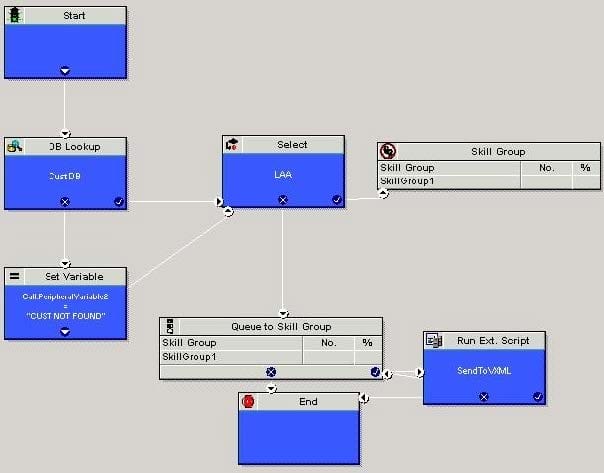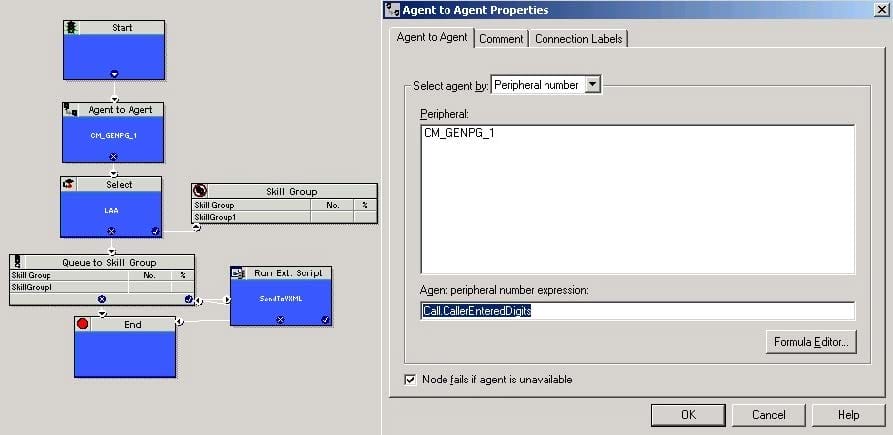642-242 Online Practice Questions and Answers
The Cisco Unified ICM call routing script can access an external database for routing or CTI data. In this script, the DB Lookup node is used to access a CustDB to look up the customer by the caller entered digits associated with the call.

What will this script do if the caller entered digits are invalid?
A. The DB Lookup node will be ignored and pass control to the Select node, with the database values left empty because the value was invalid.
B. The DB Lookup node will fail and the SET node will be used to set Call Variable 2 to "Customer Not Found".
C. The DB Lookup node will find the first row in the table, which is set to have the customer name as "INVALID DATA".
D. The DB Lookup node will fail and the SET node will be used to set Call Variable 2 to "Customer Not Found," but only if the Call Variable 2 is not already set for this call.
In the Cisco Unified Contact Center Enterprise 8.0 solution, which Cisco Unified Communications Manager Application User Group role assignments are required for the Cisco Unified Contact Center Enterprise Agent Peripheral Gateway JTAPI user? (Choose two.)
A. Standard AXL API Access
B. Standard CTI Allow Call Monitoring
C. Standard CTI Manager API Access
D. Standard CTI Enabled
E. Standard JTAPI Allow Control
A default label can be configured for a dialed number in the Cisco Unified ICM Configuration Manager.
This default label is used under which two circumstances? (Choose two.)
A. It is the default and is used in all situations.
B. If a target cannot be determined within the timeout threshold of the routing client.
C. If an ICM routing script reaches an End node without having produced a target.
D. If a RONA event occurs when attempting to deliver a call to an agent.
E. If an agent call fails due to call admission control.
In order to run the setup program for a Cisco Unified ICM Server, what are the minimum permissions that must be granted to a user?
A. domain admin, read write
B. local user, read only
C. SQL admin, read write
D. local admin, read write
E. domain admin, read only
F. ICM admin, read write
In a Cisco Unified Contact Center Enterprise using Unified IP IVR, which is the recommended practice to check for agent availability in the routing script with a route-select node to minimize IP IVR port usage?
A. after the script executes a translation route to VRU node
B. at the end of the script
C. prior to executing a translation route to VRU node
D. A route-select node should not be used in an IP IVR script.
Which task can be completed in the Cisco Unified Contact Center Enterprise Translation Route Wizard?
A. Copy an existing configured translation route in Cisco Contact Center Enterprise.
B. Create CTI route points and CTI ports in Cisco Unified Communications Manager.
C. Rename an existing configured translation route in Cisco Contact Center Enterprise.
D. Report on existing configured translation routes in Cisco Contact Center Enterprise.
When configuring a Cisco Unified ICM post-routing script in the Cisco Unified IP IVR, an application is created with the application type of Cisco ICM Post-Routing.
Which three items must be configured for that type of application? (Choose three.)
A. ICM subsystem ID
B. timeout value in seconds
C. .wav file of the Welcome prompt
D. JTAPI trigger
E. HTTP trigger
F. initial script
A Cisco Unified Contact Center Enterprise routing script can send calls directly to a pre- defined label or extension on a Cisco Unified Communications Manager IP Phone.
What is the impact of that sort of routing on the system?
A. The Cisco Unified Contact Center Enterprise solution will automatically take the call back based on the ring-no-answer settings for the agent group associated with the call if no one answers within the timeout parameter.
B. The Cisco Unified Contact Center Enterprise solution cannot send calls outside the defined range of agent extensions / device targets in the system.
C. The Cisco Unified Contact Center Enterprise solution loses track of the call and reports it as "transferred out".
D. The Cisco Unified Contact Center Enterprise solution does not lose track of the call if the call is transferred to a monitored or agent extension / device target in the system.
In the Cisco Unified Contact Center Enterprise 8.0 solution, what is the proper order to deploy a new Administration and Data Server with HDS?
A. Run the Cisco Unified Contact Center Enterprise Installer. Run the Cisco Unified Contact Center Enterprise Domain Manager if the Active Directory setup has not already been done. Run the Cisco Unified Contact Center Enterprise Web Setup Tool to add the instance to the server. Run the Cisco Unified Contact Center Enterprise ICMDBA Tool to create the HDS database. Run the Cisco Unified Contact Center Enterprise Web Setup Tool to setup the Administration and Data Server options.
B. Run the Cisco Unified Contact Center Enterprise Installer. Run the Cisco Unified Contact Center Enterprise Domain Manager if the Active Directory setup has not already been done. Run the Cisco Unified Contact Center Enterprise ICMDBA Tool to create the HDS database. Run the Cisco Unified Contact Center Enterprise Web Setup Tool to add the instance to the server and setup the Administration and Data Server options.
C. Run the Cisco Unified Contact Center Enterprise Installer. Run the Cisco Unified Contact Center Enterprise Domain Manager if the Active Directory setup has not already been done. Run the Cisco Unified Contact Center Enterprise Web Setup Tool to add the instance to the server and setup the Administration and Data Server options. Run the Cisco Unified Contact Center Enterprise ICMDBA Tool to create the HDS database.
D. Run the Cisco Unified Contact Center Enterprise Installer. Run the Cisco Unified Contact Center Enterprise ICMDBA Tool to create the HDS database. Run the Cisco Unified Contact Center Enterprise Web Setup Tool to add the instance to the server and setup the Administration and Data Server options. Run the Cisco Unified Contact Center Enterprise Domain Manager if the Active Directory setup has not already been done.
Which are three methods to ensure that Cisco Unified Contact Center Enterprise route requests that experience unexpected scripting conditions are counted as default-routed rather than errors in call type reports? (Choose three.)
A. Test your scripts to ensure that all routing logic is correct.
B. Configure default labels for each dialed number using the Configuration Manager.
C. Include a Termination node with Termination type of default label for all scripts in which there is some unexpected input.
D. In all routing scripts, account for failure by creating a path for calls that encounter unexpected conditions.
E. Configure default labels for each skill group using the Configuration Manager.
When performing an upgrade to Cisco Unified Contact Center Enterprise, which of the following components do not need to be upgraded during the same maintenance window?
A. ICM Call Router and Logger / Database Server
B. ICM Call Router and Administrative Workstation
C. Administrative Workstation and WebView server
D. Administrative Workstation and Peripheral Gateway
Which is the recommended order of installation for Cisco Unified ICM software components?
A. Call Router, Logger, first Admin Workstation/Distributor, Peripheral Gateway
B. First Admin Workstation/Distributor, Call Router, Logger, Peripheral Gateway
C. Peripheral Gateway, first Admin Workstation/Distributor, Logger, Call Router
D. Logger, Call Router, Peripheral Gateway, first Admin Workstation/Distributor
In the Cisco Unified Contact Center Enterprise solution, calls can be routed directly to agents.

In this script and agent-to-agent node, how is the agent selected?
A. The requested agent's name is stored in the Caller Entered Digits field for the call, and the system will select the agent by name.
B. The requested agent's login ID (number) is stored in the Caller Entered Digits field for the call, and the system will select the agent by number.
C. The requested agent must be logged in for the system to select that agent from Skill Group 1.
D. The script is not valid, because the call is not at an agent, so the agent-to-agent node cannot be used.
In the Cisco Unified Contact Center Enterprise solution with Cisco Unified IP IVR, how are service levels set for reporting?
A. at the Cisco Unified ICM Service in the Service Explorer tool
B. systemwide in the ICM Enterprise ConfigManager tool as a default
C. at the Cisco Unified ICM Call Type using the Call Type List tool
D. at the Cisco Unified ICM Skill Group using the Skill Group Explorer tool
Refer to the exhibit. This is the setup of the Cisco Unified Communications Manager Telephony Call Control Group.
Which two of the following is true based on this configuration? (Choose two.)
A. Callers will be unable to use keypad digits to enter numbers on these CTI ports because the Media Termination Support radio button has "No" selected.
B. The trunk group number must be defined as "112" in the Cisco Unified Contact Center Enterprise Configuration Manager tool.
C. The Device Name for the CTI ports of this group in Cisco Unified Communications Manager will be named "xxxx_CTIP" where "xxxx" is the CTI port number.
D. There are five CTI ports that begin with port number "3101" for this group in Cisco Unified Communications Manager.
E. No calls will be routed to these CTI ports because the DN Calling Search Space is set to "None".
